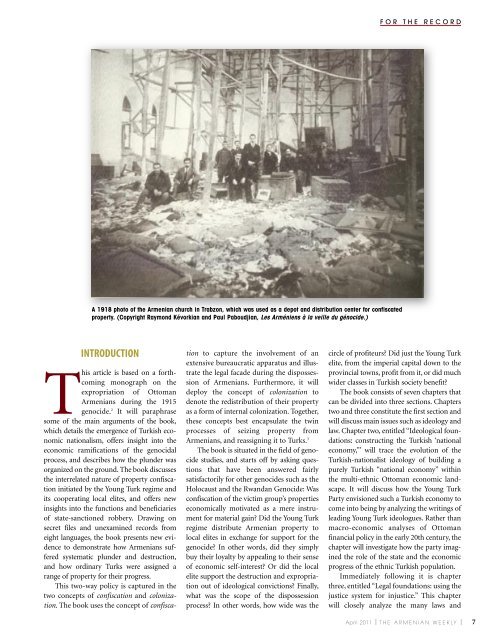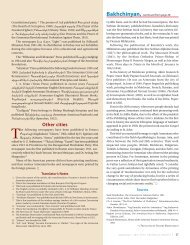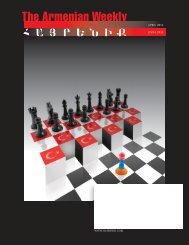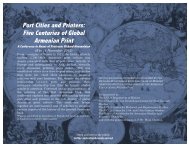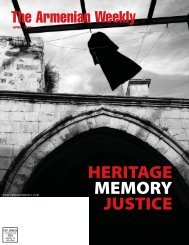Armenian Weekly April 2011 Magazine
Armenian Weekly April 2011 Magazine
Armenian Weekly April 2011 Magazine
You also want an ePaper? Increase the reach of your titles
YUMPU automatically turns print PDFs into web optimized ePapers that Google loves.
FOR THE RECORDA 1918 photo of the <strong>Armenian</strong> church in Trabzon, which was used as a depot and distribution center for confiscatedproperty. (Copyright Raymond Kévorkian and Paul Paboudjian, Les Arméniens à la veille du génocide.)INTRODUCTIONThis article is based on a forthcomingmonograph on theexpropriation of OttomanArme nians during the 1915genocide. 2 It will paraphrasesome of the main arguments of the book,which details the emergence of Turkish economicnationalism, offers insight into theeconomic ramifications of the genocidalprocess, and describes how the plunder wasorganized on the ground. The book discussesthe interrelated nature of property confiscationinitiated by the Young Turk regime andits cooperating local elites, and offers newinsights into the functions and beneficiariesof state-sanctioned robbery. Drawing onsecret files and unexamined records fromeight languages, the book presents new evidenceto demonstrate how <strong>Armenian</strong>s sufferedsystematic plunder and destruction,and how ordinary Turks were assigned arange of property for their progress.This two-way policy is captured in thetwo concepts of confiscation and colonization.The book uses the concept of confiscationto capture the involvement of anextensive bureaucratic apparatus and illustratethe legal facade during the dispossessionof <strong>Armenian</strong>s. Furthermore, it willdeploy the concept of colonization todenote the redistribution of their propertyas a form of internal colonization. Together,these concepts best encapsulate the twinprocesses of seizing property from<strong>Armenian</strong>s, and reassigning it to Turks. 3The book is situated in the field of genocidestudies, and starts off by asking questionsthat have been answered fairlysatisfactorily for other genocides such as theHolocaust and the Rwandan Genocide: Wasconfiscation of the victim group’s propertieseconomically motivated as a mere instrumentfor material gain? Did the Young Turkregime distribute <strong>Armenian</strong> property tolocal elites in exchange for support for thegenocide? In other words, did they simplybuy their loyalty by appealing to their senseof economic self-interest? Or did the localelite support the destruction and expropriationout of ideological convictions? Finally,what was the scope of the dispossessionprocess? In other words, how wide was thecircle of profiteurs? Did just the Young Turkelite, from the imperial capital down to theprovincial towns, profit from it, or did muchwider classes in Turkish society benefit?The book consists of seven chapters thatcan be divided into three sections. Chapterstwo and three constitute the first section andwill discuss main issues such as ideology andlaw. Chapter two, entitled “Ideological foundations:constructing the Turkish ‘nationaleconomy,”’ will trace the evolution of theTurkish-nationalist ideology of building apurely Turkish “national economy” withinthe multi-ethnic Ottoman economic landscape.It will discuss how the Young TurkParty envisioned such a Turkish economy tocome into being by analyzing the writings ofleading Young Turk ideologues. Rather thanmacro-economic analyses of Ottomanfinancial policy in the early 20th century, thechapter will investigate how the party imaginedthe role of the state and the economicprogress of the ethnic Turkish population.Immediately following it is chapterthree, entitled “Legal foundations: using thejustice system for injustice.” This chapterwill closely analyze the many laws and<strong>April</strong> <strong>2011</strong> | THE ARMENIAN WEEKLY | 7


